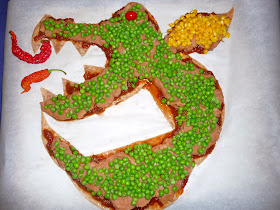Happy Mendel's Birthday to all! As Google let us know, it is the 189th birthday of Gregor Mendel, the Austrian scientist who first recorded the patterns of reproduction, famously breeding peas to see what traits were passed onto the next generation, and thus earned the title of Father of Genetics.
Like I've said before, we like to celebrate everything around here, so we had a Gregor Mendel birthday party today. We invited some friends over and together did an activity based on Mendel's cross-breeding peas experiment. But since we didn't have the time for new plants to grow, plus peas aren't really that exciting for middle school-aged students, we did a simulated cross-breeding of a much more interesting life form suggested by our recent excursion to see the last Harry Potter movie--we did our simulated gene pool analysis based on breeding dragons! We used a wonderful lesson plan developed at Vanderbilt and added onto by former middle school teacher Nancy Clark called "Inheritance Patterns in Dragons," which you can download from this page. (But if you aren't into dragons, but are into Harry Potter, there is another site where you can map the genetic path through which Muggles can produce witches and wizards and magical folk can have Squibbs from the National Institute of Health.)
After a general explanation of DNA and genetics, each student chose a set of seven "genes" with different dominant or recessive traits from the same male and female parents.
However, a worksheet helped them figure out what traits would be expressed in each specific offspring (fire breathing vs. no fire, number of toes or spines, color of body, wings, and tale, etc.). Then each student drew a picture of a dragon with the genetic trails of that pairing.
So, for example, all the dragons (different in style though they might be) had blue bodies--obviously a dominant trait. Three of the four had red wings and red tails; however, one had yellow wings and a yellow tail. This demonstrates the fact that the same parents can produce a smaller number (statistically) of offspring with recessive trails, even if the parents themselves don't show those traits.
Anyway, the students really enjoyed it, and seemed to be clear about the basics of genetic inheritance after doing this exercise.
Plus, because it was, after all, a birthday party, I made a dish of Dragon Dip:
This is basically a healthier and vegan version of nachos, with whole wheat tortillas as the skeleton, tomato salsa as the blood, refried bean dip as the muscle, and, in honor of Mendel, peas as the dragon skin (except for the wings, where the skin is made of corn. It is finished off with a grape tomato for its eye and dried jalapeno peppers as the fire breathing part, heated in the oven until hot, and them consumed with dragon skills (tortilla chips).
There are also some great online resources to use to explore this topic. BioLogica has two web labs on genetics: an online dragon genetics simulation, and animations of topics like meiosis along with a pea breeding experiment (like Mendel's) that is based on the fairy tale of the Princess and the Pea. The Pea Soup website tells Mendel's story, as well as having an interactive simplified simulation of the pea experiment.
This is a fun topic to explore with middle schoolers, especially if you can include some of these more imaginative resources.....and everything goes better with some dragon-based food!







No comments:
Post a Comment